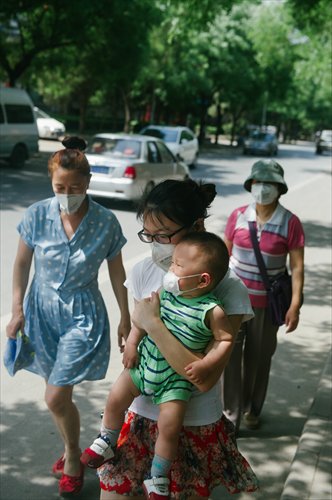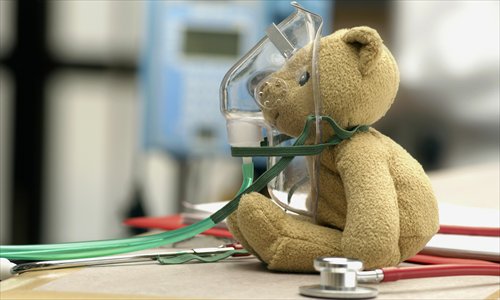Facing down MERS
China takes measures against SARS-like virus

Prevention and control measures have been taken so that Beijing is ready for possible MERS cases entering the city. Photo: Li Hao/GT
The MERS (Middle East Respiratory Syndrome) virus has been getting a lot of public attention in China after China's first confirmed patient, a 44-year-old male from South Korea, tested positive for it on Friday, May 29. The man had traveled to Huizhou, Guangdong Province after flying to Hong Kong on May 26, and local authorities found him on May 27.
On China's social networking site Sina Weibo, the topic "MERS invading Guangdong" alone has been commented on 400,000 times and viewed 180 million times.
According to the World Health Organization (WHO), the coronavirus that caused MERS (MERS-CoV) was first identified in 2012 in Saudi Arabia. Medical experts' understanding of the virus and the disease is still evolving. As of June 1, WHO has been notified of 1,154 laboratory-confirmed cases of infection with MERS-CoV, including at least 431 related deaths.
Some Net users in China are criticizing South Korean health officials for allowing the patient to travel to China despite warnings from doctors, and others are worried that it might cause unnecessary panic among the public. In many Chinese media reports, MERS-CoV is often associated with the virus that caused SARS (severe acute respiratory syndrome) and its outbreak in China in 2003.
But Liu Youning, a professor in epidemiology and respiratory medicine at Chinese PLA General Hospital and a member of the Chinese Thoracic Society, said that overall, things are different this time regarding the reaction of the Chinese public to this latest MERS case.
"I think, because of SARS, the people, the authorities and the medical institutions are all prepared this time and aren't panicking," he said.

Medical experts' understanding of MERS is still evolving, and there's no vaccine or specific treatment so far. Photo: IC
The new SARS?
Liu, who actively participated in SARS research and the treatment of SARS patients in 2003, told Metropolitan there actually is basis for comparison between the two diseases.
"The viruses are similar because they fall under the coronavirus category, which is different from the flu or Ebola," Liu said. Both affect the respiratory system - SARS mainly affects the lungs, while MERS also affects the kidneys, according to Liu.
Both SARS and MERS-CoV are transmitted from animals. MERS-CoV has been found in camels in several countries, although more evidence is needed to identify the role camels or other animals play in the transmission, Liu said.
About three to four out of every 10 patients reported with MERS have died, according to US Centers for Disease Control and Prevention. Common MERS-CoV symptoms include fever, cough and shortness of breath, while there also have been reported conditions such as pneumonia and gastrointestinal symptoms. In severe cases, MERS can cause respiratory failure. Some cases also show multi-organ failure and septic shock.
Because the symptoms are similar to those of other respiratory infections, it's difficult to identify MERS patients at early stages, according to WHO.
Based on available information, there's evidence of neither sustained human-to-human transmission, nor airborne transmission of MERS-CoV.
"The reason why SARS caused panic was because some patients didn't get timely, proper treatment, and the other factor was that the virus was very contagious," Liu said.
"By far, MERS-CoV is known to be able to be transmitted human to human, but it's not sustained transmission, and the infection rate is not as high as SARS."
However, mortality rate is much lower for SARS cases. With the proper treatment, it can be as low as 5 percent, said Liu.
Fighting the virus
The authorities and medical institutions have taken emergency measures in the face of China's first case.
Medical experts are actively treating the South Korean patient at the Huizhou Municipal Central Hospital. The tracing and monitoring of close contacts of the first patient is also underway. As of June 1, among the 77 people who had been in close contact with the patient, 67 have been quarantined while 10 others remain out of contact. Those quarantined have shown no signs of having the illness so far, according to the Health Department of Guangdong Province.
According to the WHO China Representative Office, China has very good systems in place for "responding in situations like this, which were strengthened and fine-tuned during the global Ebola outbreak" last year.
"However, it is important to remain vigilant, by ensuring that strong monitoring and surveillance systems, along with good infection prevention and control procedures in healthcare facilities, are in place," said Dr. Bernhard Schwartländer, WHO Representative in China.
Medical experts and institutions worldwide have been exploring the possibility of understanding and treating the disease since 2012. However, according to Liu, there is no vaccine to prevent or specific medicine to treat a MERS-CoV infection yet, although medical care can help relieve symptoms.
"Having no medicine doesn't mean the patient will die. We can use other supportive treatment."
Liu said that although people's knowledge and experience with treating MERS is not sufficient, what medical teams learned when fighting SARS in 2003 can be applied in the prevention and control of MERS.
Liu said that when working with patients, doctors should use eye protection and airborne precautions because there is still much to be learned about the transmission of the disease.
In Liu's experience with SARS, providing the patient oxygen through a respirator is one of the main methods of treatment, and adrenocortical hormones also proved to be effective for those with the more severe cases of respiratory failure or kidney damage.
"I think another lesson we learned from SARS is that we shouldn't use hormones prematurely," Liu said.
He said that many SARS patients now suffer from osteonecrosis and osteoporosis because they received a large dosage of hormones during treatment. "I call for doctors to be discreet and not use hormones blindly."
Is Beijing MERS-proof?
The capital city has active international communication and interactions, and Beijing authorities are not ruling out the possibility of the disease entering city.
Beijing Center for Diseases Prevention and Control (CDC) said on its official website on May 29 that there is evidence that shows the possibility of an epidemic outbreak is low, but Beijing still faces risks of imported cases.
Pang Xinghuo, epidemiologist and vice director of Beijing CDC, told Metropolitan that the center is having close and timely information exchanges with Guangdong medical authorities regarding MERS.
"So far, we have received no notification regarding anyone in close contact of the first patient entering Beijing," Pang said. But the possibility of those who have come in close contacts with the MERS patients entering Beijing still exists, she said.
It's crucial for doctors to ask about a patient's travel history and exposure record, Pang added.
On May 31, the Beijing News confirmed with Beijing Ditan Hospital that the posts circulating online about the hospital admitting a possible MERS case are false.
"It's a good thing that [people in Beijing] have the awareness and sensitivity [regarding public health emergency events like this], but they need to pay attention to learning about the virus, and they should do it from official, formal government websites or media," Pang said.
According to Pang, Beijing is prepared in every possible way. Beijing has put great importance on the prevention and control of MERS since 2012. Beijing is capable of monitoring and testing for MERS-CoV because doctors and researchers have developed methods of testing for MERS-CoV.
There has also been MERS training and drills every year in Beijing's disease prevention and control system. In the face of the recent challenge, Pang said that there will be a citywide intensive training program for medical staff in Beijing within the next few days.
Beijing had already appointed Beijing Ditan Hospital and Beijing YouAn Hospital to be assigned MERS treatment centers in case of an outbreak, the Beijing News reported.
Liu Zeying, a doctor from Beijing Anzhen Hospital's department of respiratory medicine, said patients recently coming to the hospital with symptoms of acute respiratory conditions are not panicking about the recent news coverage of MERS at all.
"We definitely will ask about a patient's travel history," she said, adding that medical staff have been trained and have kept up-to-date regarding MERS since 2012.
What to do
According to WHO, until more is understood about the disease, people under high risk of a severe condition from a MERS-CoV infection are considered to be those with diabetes, renal failure, chronic lung disease, and immunocompromised persons, who are advised to avoid close contact with animals, especially camels.
Liu Zeying recommends that people stick to strict, basic hygiene measures, including washing hands, eating properly cooked animal meat, and wearing a mask in places with a high population density and poor ventilation, or avoiding go to those places altogether.
Beijing CDC reminds citizens to avoid close contact with people with respiratory infection symptoms, such as a fever, runny nose and cough, and those with such symptoms should see a doctor as soon as possible.
WHO doesn't advise special screening at points of entry, or application of any travel or trade restrictions be taken at this point, but experts pointed out that fully educating the public is important.
"Inform people of everything, including the high mortality rate so that they'll be alerted, and also the fact that it's not highly contagious, so people won't panic," Liu Youning said.
Know your MERS and SARS
These facts were compiled based on information released by WHO and the Chinese Center for Disease Control and Prevention as well as information provided by epidemiologists interviewed by Metropolitan.
SARS
Type of virus: Coronavirus
Year recognized: 2003
Possible animal source: Bats
Transmission: Direct mucous membrane (eyes, nose, and mouth) contact through infectious respiratory droplets and/or through exposure to fomites (germs, parasites)
Number of reported cases: 8,437 (As of July 11, 2003)
Mortality rate: 10 percent
Vaccine: No
MERS
Type of virus: Coronavirus
Year recognized: 2012
Possible animal source: Camels
Transmission: For known cases, close contact, such as caring for or living with an infected person
Number of reported cases: 1,154 (As of June 1, 2015)
Mortality rate: 30-40 percent
Vaccine: No